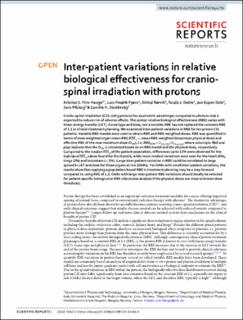| dc.contributor.author | Ytre-Hauge, Kristian | |
| dc.contributor.author | Fjæra, Lars Fredrik | |
| dc.contributor.author | Rørvik, Eivind | |
| dc.contributor.author | Dahle, Tordis Johnsen | |
| dc.contributor.author | Dale, Jon Espen | |
| dc.contributor.author | Pilskog, Sara | |
| dc.contributor.author | Stokkevåg, Camilla Hanquist | |
| dc.date.accessioned | 2021-04-22T11:15:53Z | |
| dc.date.available | 2021-04-22T11:15:53Z | |
| dc.date.created | 2020-09-17T14:29:24Z | |
| dc.date.issued | 2020 | |
| dc.Published | Scientific Reports. 2020, 10:6212 1-9. | |
| dc.identifier.issn | 2045-2322 | |
| dc.identifier.uri | https://hdl.handle.net/11250/2739116 | |
| dc.description.abstract | Cranio-spinal irradiation (CSI) using protons has dosimetric advantages compared to photons and is expected to reduce risk of adverse effects. The proton relative biological effectiveness (RBE) varies with linear energy transfer (LET), tissue type and dose, but a variable RBE has not replaced the constant RBE of 1.1 in clinical treatment planning. We examined inter-patient variations in RBE for ten proton CSI patients. Variable RBE models were used to obtain RBE and RBE-weighted doses. RBE was quantified in terms of dose weighted organ-mean RBE (RBEd = mean RBE-weighted dose/mean physical dose) and effective RBE of the near maximum dose (D2%), i.e. RBED2% = D2%,RBE/D2%,phys, where subscripts RBE and phys indicate that the D2% is calculated based on an RBE model and the physical dose, respectively. Compared to the median RBEd of the patient population, differences up to 15% were observed for the individual RBEd values found for the thyroid, while more modest variations were seen for the heart (6%), lungs (2%) and brainstem (<1%). Large inter-patient variation in RBE could be correlated to large spread in LET and dose for these organs at risk (OARs). For OARs with small inter-patient variations, the results show that applying a population based RBE in treatment planning may be a step forward compared to using RBE of 1.1. OARs with large inter-patient RBE variations should ideally be selected for patient-specific biological or RBE robustness analysis if the physical doses are close to known dose thresholds. | en_US |
| dc.language.iso | eng | en_US |
| dc.publisher | Nature Research | en_US |
| dc.rights | Navngivelse 4.0 Internasjonal | * |
| dc.rights.uri | http://creativecommons.org/licenses/by/4.0/deed.no | * |
| dc.title | Inter-patient variations in relative biological efectiveness for craniospinal irradiation with protons | en_US |
| dc.type | Journal article | en_US |
| dc.type | Peer reviewed | en_US |
| dc.description.version | publishedVersion | en_US |
| dc.rights.holder | Copyright The Author(s) 2020 | en_US |
| dc.source.articlenumber | 6212 | en_US |
| cristin.ispublished | true | |
| cristin.fulltext | original | |
| cristin.qualitycode | 1 | |
| dc.identifier.doi | 10.1038/s41598-020-63164-8 | |
| dc.identifier.cristin | 1830892 | |
| dc.source.journal | Scientific Reports | en_US |
| dc.source.40 | 10:6212 | |
| dc.identifier.citation | Scientific Reports. 2020, 10, 6212. | en_US |
| dc.source.volume | 10 | en_US |

